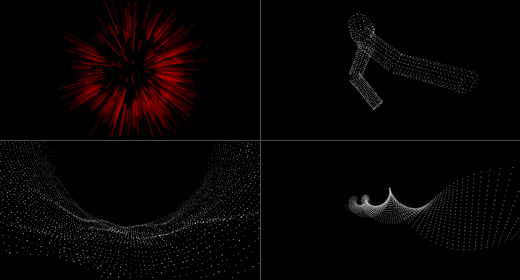3D experiments with Flash Player 10 and AS3Dmod

Flash Player 10 has been around for a few months now. As most of you know, it brings some native 3D support.
It's not as robust as Papervision3D or Away3D, and in fact was not designed to compete with those engines. Rather than that, it contains classes that perform 3D calculations and allows basic 3D manipulation of display objects.
The last months I focused on catching up with 3D math. I ordered a book called "3D Math Primer", which explains in detail all the vector and matrix operations involved in 3D graphics. Even though the examples are in C++ I recommend this book to anyone doing 3D in Flash. The authors made a great effort to explain the subject with clarity. It worked pretty well for me and I understand the math behind 3D much better now.
Both Papervision3D and Away3D were created so that we don't have to deal directly with 3D calculations. If you are working on a project that involves non-trivial 3D and has a deadline, it's better to choose one of those engines instead of "pure Flash Player 10".
However, if you just want to do some casual experiments and learn something on the way, FP10 is great. It offers a small number of tools, focused around Vector3D and a Matrix3D classes. These classes offer low level functionality, so to use them one needs to understand what's going on under the hood. This is a great way to learn!
Then I had this idea to port AS3Dmod to Flash Player 10 and try to run the modifiers on objects created using FP10 3D classes. It turns out it was not so difficult. Instead of rendering textured 3D objects I just render a single pixel for each vertex. Thanks to this I get a relatively good performance even with as much as 8000 vertices. I found that a modifier applied to such a large amount of vertices, gives interesting visual effects. I even wrote a very simple Wavefront OBJ importer, and I could import the 3d pants model from one of my previous posts to render them in Flash Player 10.
All my previous demos with AS3Dmod involved pretty small amount of vertices – most often no more than 500-600. At this level the performance of the modifiers was not a problem. But with 8000 vertices the modifiers start to have an big impact on the frame rate. A Perlin modifier alone takes 4-5 FPS, which is quite a lot and it got me worried. I believe code optimizations are in order. An interesting solution could be to implement the modifiers as a Pixel Bender kernels. Anyway, I need to do some more research…
In the AS3Dmod SVN you'll find the FP10 branch. The main difference between this version and the trunk is that it uses FP10 built-in Vector3D and Matrix3D classes as well as Vectors instead of Arrays. The sources for all experiments mentioned above, including a simple AS3Dmod plugin for FP10, are available here.
Demos: [ 1 ] [ 2 ] [ 3 ] [ 4 ] Flash Player 10 required (obviously)
